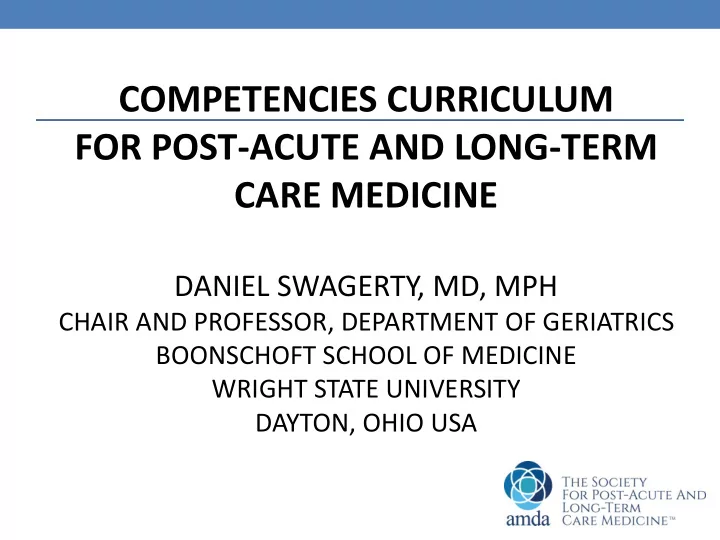

COMPETENCIES CURRICULUM FOR POST-ACUTE AND LONG-TERM CARE MEDICINE DANIEL SWAGERTY, MD, MPH CHAIR AND PROFESSOR, DEPARTMENT OF GERIATRICS BOONSCHOFT SCHOOL OF MEDICINE WRIGHT STATE UNIVERSITY DAYTON, OHIO USA
Competencies Curriculum • Defined competencies for the practice of post- acute and long-term care (PA/LTC) medicine • Evidenced-based framework for the unique knowledge and skills needed to facilitate quality outcomes in the PA/LTC setting • Designed for attending physicians and other medical providers who practice in this setting
Organizational Support Wide Range of Stakeholders in Developing Competencies and Educational Training Curriculum • Advancing Excellence • American Academy of Family Physicians • American Academy of Home Care Physicians • American College of Healthcare Administrators • American Health Care Association • American Society of Consultant Pharmacists • Gerontological Advanced Practice Nurses Association • Leading Age • National Association of Directors of Nursing Administration
Target Audience Target audience for online training are medical providers that practice in PA/LTC setting – Attending Physicians – Geriatric Fellows – Nurse Practitioners – Physician Assistants
Competencies Curriculum Five Domains with sections, which have pre/post tests, interactive content and cases, questions and evaluations I. Foundation (Ethics, Professionalism and Communication) II. Medical Care Delivery Process III. Systems IV. Medical Knowledge V. Personal Professional Development in Post-Acute and Long-Term Care
Domain I: Foundation (Ethics, Professionalism and Communication) • Module 1.1 Application of Ethical Principles in Clinical Decision-Making • Module 1.2 Clinical Implications of Legal and Regulatory Requirements • Module 1.3 Recognizing and Adapting to Patient Limitations and Impairments • Module 1.4 Optimizing Communication with Patients and Families • Module 1.5 Culturally Sensitive Interactions with Patients, Families and Staff • Module 1.6 Elements of Appropriate and Timely Practitioner Performance
Domain II: Medical Care Delivery Process • Module 2.1 Applying the Care Delivery Process to Patient Care • Module 2.2 Developing a Person-Centered Evidence- Based Medical Care Plan • Module 2.3 Identifying and Incorporating Prognosis into Care Decisions • Module 2.4 Principles of Palliative and End-of-Life Care • Module 2.5 Developing Effective Palliative and End- of-Life Care Plans
Domain III: Systems • Module 3.1 Providing Prudent and Minimally Disruptive Care • Module 3.2 Using Patient Databases in Clinical Practice • Module 3.3 Determining Appropriate Levels of Care • Module 3.4 Optimal Management of Care Transitions • Module 3.5 Working Effectively with the Interdisciplinary Care Team • Module 3.6 Understanding and Explaining the Impact of Finances on Care Decisions
Domain IV: Medical Knowledge • Module 4.1 Identifying and Managing Changes in Condition • Module 4.2 Formulating a Pertinent and Adequate Differential Diagnosis • Module 4.3 Identifying and Developing a Person-centered Medical Plan • Module 4.4 Minimizing Risk and Optimizing Patient Safety • Module 4.5 Managing Pain Safely and Effectively • Module 4.6 Prescribing Medications Prudently and Effectively
Domain V: Personal Professional Development in Post-Acute and Long-Term Care • Module 5.1 Developing a Personal Professional Development Plan • Module 5.2 Utilizing Quality-Related Information to Improve Care • Module 5.3 Using Patient Outcomes to Improve Practice
Competencies Curriculum Online Course • Web-based – access with any device connected to internet • Asynchronous – any time and at ones own pace within 60 days of purchase • Case studies – real life scenerios • Pre- and post-test questions • Evaluations • Certificate
Continuing Education Credit • 12.5 Physician AMA PRA Category I Credit TM • 12.5 CMD Credit 2.25 management 9.25 clinical • 12.5 Nursing Continuing Education Units
Customer Reviews • Great presentations. • Good review, reality of practice exceeds regulations generally. • The material was very informative, practical and useful for PA/LTC practice • Very effective modules. • Very logical presentations.
Log-In
Pre-Assessment
2.4 Principles of Palliative and End-of-Life Care
Learning Objectives • Compare and contrast the elements of curative, palliative and end-of-life care • Identify barriers to optimal end-of-life care • Analyze strengths and weaknesses of end-of-life care in various locations of care
Palliative Care • A model of care that focuses intensively on – Expert medical care – Aggressive pain and symptom management, and – Emotional and spiritual support tailored to the patient’s wishes • Support is also provided to the patient’s loved ones • This requires an interdisciplinary team approach
Palliative Care: Operational Definition • Definition – Care focused on relief of symptoms of illness, as well as psychological and spiritual issues • Goal is to prevent and/or ease suffering, and to offer patients and their families the best possible quality of life • May be appropriate at any point in an illness – It is not dependent on prognosis • Can also be provided at the same time as curative and life-prolonging treatment
Palliative Care • Palliative care can be provided whether an illness is potentially permanent, life-threatening, or chronic • Palliative care is reimbursed as part of regular medical care, no special Med A benefit • Hospice is a subset of palliative care that focuses on the last six months of a terminal illness
Palliative Care • Palliative care teams are typically hospital-based – 1,734 out of 2,844 US hospitals with greater than 50 beds reported having palliative care teams in 2012 • Teams consist of at least a dedicated physician and nurse, and often include a social worker • Hospice and Palliative Medicine (HPM) is a recognized medical subspecialty – However, it is very feasible for physicians to provide palliative care without needing a specialty designation
Questions? AMDA – The Society for Post-Acute and Long-Term Care Medicine education@paltc.org 410-992-3140
Recommend
More recommend